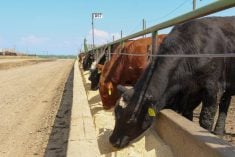During the second week of April, Alberta packers were buying live fed cattle in the range of $229-$230/cwt f.o.b. feedlot in southern Alberta. This is up approximately $7 from mid-April. Breakeven pen closeouts are around $220/cwt.
After struggling for nearly three years in a row, feeding margins have finally moved into positive territory. Strength in the fed market has transferred into the feeder complex. As of earl May in central Alberta, Angus-blended, lower-flesh steers on light grain ration with full health data averaging 842 pounds were valued at $270. In the same region, tan steers weighing 650 pounds were valued at $320.
Feed barley prices continue to hover in the range of $415-$425/tonne in southern Alberta. However, Canadian farmers are expected to increase barley acres this spring. Export demand for Canadian barley during the 2023/24 crop year will be down sharply from a year ago. Larger supplies and weaker demand for Canadian barley will result in lower prices. This has contributed to the stronger market for replacement cattle.
Read Also

Harvest wraps up and fall work begins
At the Eppich famly ranch in western Saskatchewan, the fall harvest was successful with few breakdowns, cows and calves have been sorted and a new tractor has arrived
Feedlot numbers down
U.S. cattle on feed for slaughter in feedlots with 1,000-head plus capacity as of April 1 totalled 11.612 million head, down four per cent or 533,000 head from 12.145 million head on April 1, 2022. Lower placements during the fall and winter resulted in in the sharp-year-over-year decline in on-feed numbers for the first half of 2023. Quarterly beef production was down sharply in the first quarter of 2023 and this trend will continue in the second quarter.
The U.S. feeder cattle placement schedule has been rather unique this year. Despite the drier conditions in the U.S. Southern Plains, cattle grazing on small-grain pasture over the winter in Kansas, Texas and Oklahoma were only down about 80,000 head from last year. Therefore, feedlot placements in the lighter weight categories have only been marginally lower than year-ago levels during the first quarter of 2023.
During March, total U.S. feedlot placements were only down one per cent or 13,000 head from March of 2022. U.S. market-ready supplies of fed cattle will be rather burdensome during July and August. The market is going to be in a transition stage from an extremely tight situation during the spring to a heavy supply environment in July and August.
U.S. beef production during July and August will be similar to a year ago. The USDA estimated third-quarter beef production at 6.8 billion pounds. The industry believes the actual output will finish closer to 6.9 billion. September will be the month when supply drops off again.
The western Canadian fed cattle market will contend with similar fundamentals. Market-ready fed cattle numbers in Alberta and Saskatchewan are down significantly during May and June. During July, supplies transition to a more balanced fundamental situation. Again, it’s important to look at placements by month by weight. There is downside potential in the fed cattle market during July and August. Feedlots are holding high-priced feeders purchased in April and May. Alberta feedlot margins will dip into negative territory during July and August.
Signal to expand production
The feeder market is functioning to encourage expansion. U.S. beef cow slaughter has dipped below year-ago levels. The beef cow slaughter during the summer and fall will determine the year-over-year increase or decrease in the 2023 calf crop. Recent rains in Texas and the grazing states like Colorado have improved pasture conditions. The industry is bracing for a sharp increase in U.S. heifer retention this fall.
Approximately 45 per cent of the calves born in Canada are in Alberta. Pasture conditions are poor and forage supplies could be limited this fall. The expansion process may be delayed in Western Canada due to the adverse dry conditions. Alberta is the largest barley-producing province, so downside in barley is not a guarantee.
There is a bullish case for the feeder cattle market. We expect to see 500-pound steer calves reach up to the $400/cwt this fall in southern Alberta. Steers averaging 850 pounds could touch the psychological range of $290-$300/cwt. This is based on feed barley dropping under $300/tonne or $6.50/bu. in Lethbridge during September and October.
The fed cattle market has downside potential during July and August. During the final quarter of 2023, fed cattle prices are expected to ratchet back to historical highs. The feeder market is expected to trend higher from July through November. Keep in mind this is dependant on the feed grain price structure. If Western Canada has to import 3.5 million tonnes of U.S. corn due to the shortfall in barley production, feeder cattle prices are not going that high.
















